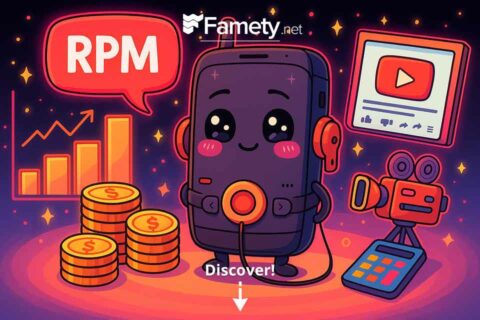- CPV stands for Cost Per View: a payment model on YouTube where advertisers pay when their video ad is watched or interacted with.
- A ‘view’ for CPV purposes typically means the viewer watched 30 seconds or more of the ad, or interacted with a CTA overlay.
- Lowering CPV involves refining your ad creative, targeting, format and bidding strategy—not just chasing the lowest rate.
- For creators, understanding CPV helps evaluate brand deals, ad revenue potential and the broader video economics ecosystem.
If you’re diving into YouTube advertising or reviewing campaign metrics, you’ve likely come across the acronym CPV. But what exactly is CPV (Cost‑Per‑View), how does it apply to YouTube, and why should creators and advertisers understand it? In this article, we’ll unpack CPV on YouTube, explain how it’s calculated, compare it to other ad metrics, cover best practices, and help you make the most of this key measurement.
What Does CPV Stand For?
CPV stands for “Cost Per View.” It is a pricing model in digital video advertising especially on platforms like YouTube where an advertiser pays each time a viewer watches or interacts with a video ad.
In practical terms, if you run a YouTube ad campaign and are using CPV bidding, you might only be charged when someone watches 30 seconds of your ad (or the full ad if it’s shorter), or interacts with a call‑to‑action overlay, depending on the format. Think of it as paying for attention, not just impressions.
How Does CPV Work on YouTube?
On YouTube, CPV is primarily used for video advertising campaigns, typically under Google Ads (formerly AdWords). Here’s a breakdown:
What counts as a “view”?
- For in‑stream ads (skippable or non‑skippable), a view might be counted when someone watches 30 seconds or the entire ad if it’s shorter.
- For in‑feed (or discovery) ad formats, a view may count when a user clicks on the thumbnail or watches at least 10 seconds.
- Each ad format defines what the threshold is and thus what triggers a CPV charge for the advertiser.

How CPV bidding works
When setting up a YouTube video ad campaign in Google Ads, advertisers can select a Target CPV bid. This is the maximum amount the advertiser is willing to pay for each view that meets the criteria defined by the ad format. Google will then try to optimize placement to maximize views at or below that bid.
In reporting, Google shows the actual CPV values, so advertisers can monitor how much each view cost across the campaign.
Why advertisers use CPV
Because CPV means you only pay when someone actually watches or interacts with the ad not just when the ad loads or is shown this model promotes cost‑efficiency and ensures you pay for actual engagement.
CPV vs CPM vs CPCV: Know the Difference
Understanding CPV means comparing it to related metrics:
- CPM (Cost Per Mille/Thousand Impressions): Here, you pay per 1,000 impressions, regardless of how long the viewer watched the ad.
- CPV (Cost Per View): You pay when the viewer watches a threshold amount (e.g., 30 seconds) or interacts.
- CPCV (Cost Per Completed View): A model where you pay only if the viewer watches the full ad.
Advertising platforms favor CPV for video because it aligns payment with meaningful consumption rather than just exposure.
What Is a “Good” CPV on YouTube?
Because CPV varies by industry, ad format, audience, and context, there’s no one size‑fits‑all benchmark. However:
- Many sources show CPV rates for YouTube‑based ads around $0.02 to $0.10 per view, depending on region and targeting.
- A “high” CPV may indicate strong competition for that audience or sub‑optimal ad creative or targeting.
- Rather than chasing the lowest CPV alone, aim for cost‑effective outcomes: views that convert, lead to clicks, or drive action.
Comparing your own CPV over time, or across similar campaigns, is more valuable than comparing to a generic benchmark.
How to Lower CPV and Improve Efficiency
If you’re a marketer running YouTube ads, here are ways to improve your CPV (i.e., get more views for less cost):
- Improve Ad Creative: A compelling thumbnail, strong hook in the first 5‑10 seconds, and clear value proposition help reduce early drop‑off.
- Refine Targeting: Reach audiences who are more likely to watch and engage. Narrow demographics, interests, or remarket to warm audiences. Mistargeting drives up CPV.
- Use the Right Ad Format: Match ad format to campaign goal (awareness vs conversion) and budget. Different formats have different view thresholds, which affect CPV.
- Optimize Bidding Strategy: Set realistic max CPV bids, use automated bidding or experiment with target CPV vs manual, and monitor frequently.
- Testing & Iteration: Test creatives, audiences, placements, and compare CPV + view‑rate + conversion metrics to find what works.
- Improve View‑through Metrics: Longer view duration, interacting viewers, and engaged audiences often lead to better CPV outcomes because YouTube sees value.
- Leverage Smart Placements: Use placements where ad spend is efficient and cost per view tends to be lower (e.g., mobile, certain geos, less competitive niches).
CPV’s Relevance to Creators (Not Just Advertisers)
While CPV is mostly an advertiser metric, it has relevance to creators too:
- If you monetize via YouTube’s Partner Program and also run ads, understanding how much advertisers pay (CPV) gives insight into ad revenue potential.
- Creators can work with brands to negotiate campaigns using CPV or similar models, making it more transparent how each view contributes to cost.
- If you’re offering sponsored video placements or product integrations, knowing market CPV benchmarks helps you price your channel appropriately.
Although creators don’t pay CPV themselves for organic uploads, being aware of how the video ad economy works can inform strategy and monetization. You should increase YouTube views and stay relevant.
Common Mistakes and Myths
- Myth: “CPV is irrelevant if I only upload organic videos.” Not true while you may not set bids, the ad ecosystem still affects your revenue structure and understanding CPV helps you evaluate brand deals or channel partnerships.
- Mistake: Comparing CPV across wildly different industries or geos without adjustment. CPV depends heavily on targeting, market, and ad format what works for one niche might not apply to another.
- Mistake: Chasing lowest CPV blindly. It’s tempting to treat CPV like a unit cost but if views are low quality (short duration, disengaged) they won’t achieve campaign goals. Balance cost with outcome.
Final Thoughts
In summary, when you ask “What is CPV on YouTube?”, you’re looking at a fundamental metric in video advertising: Cost‑Per‑View the amount an advertiser pays each time a viewer watches a video ad (or interacts) under defined conditions. For creators and marketers alike, understanding CPV means knowing how much attention is bought, how efficient campaigns are, and how to improve from there.
Summary by Editor: MCN stands for Multi‑Channel Network: a company that partners with multiple YouTube creators to provide services and revenue‑shari...
Summary by Editor: “CC” on YouTube stands for Closed Captions—text tracks viewers can enable to read what’s spoken or heard in the video. Closed cap...
By combining strong creative, smart targeting, and continuous optimization, you can lower CPV, get more value for each view, and amplify the impact of your YouTube video ad budgets. Whether you’re a brand, agency, or creator exploring monetization, CPV is one of those metrics you can’t afford to ignore.







